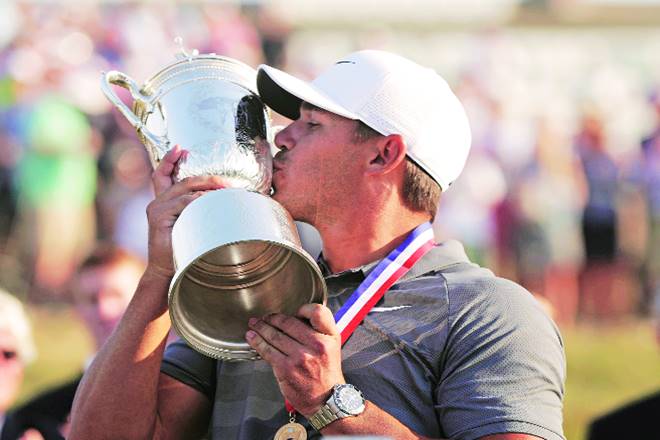Three players put on quite a show at the US Open last month: Brooks Koepka gobsmacked the golf world by becoming the first man in 29 years to successfully defend a US Open title; Tommy Fleetwood narrowly missed shooting a US Open record eight-under 62 that would have got him into a playoff; and world number one Dustin Johnson, the bookies’ favourite to win the title, led after 54 holes, but lost his way in the final round. With this performance, Koepka has established himself as one of those rarest-of-rare players who seem to play their best in Major Championships. He becomes only the third golfer—along with Rory Mc Ilroy and Jordan Spieth—to have multiple Major wins before the age of 30. In the 18 Majors that he’s played in his career, Koepka has notched up 11 consecutive top 25 finishes and 18 overall—an astonishing stat for someone who has only one victory on the PGA Tour apart from his consecutive US Open titles.
At Shinnecock Hills, Koepka ranked second in driving distance averaging over 318 yards off the tee, managed to hit 64% of fairways and 68% of greens. Almost as impressive as the 82% fairways hit and 86% greens in regulation that he managed at Erin Hills in 2017. This rare combination of power and accuracy, coupled with a sublime touch around the greens, is what makes Koepka such a versatile player: Erin Hills needed to be bombed into submission, while Shinnecock Hills was all about accuracy off the tee and nifty course strategy, and Koepka had all the answers.
Tommy Fleetwood’s charge on Sunday included eight birdies and a bogey, yet the Englishman was left ruing the eight-footer he missed on the 72nd hole. “Obviously, that’s the putt that will play on your mind because that was the last shot you hit, and that was your chance,” Fleetwood said. “But I missed some putts in the week. I made some putts. I think everybody did. And your score is your score.” Fleetwood was seven-under-par for his round through 15 holes and had great birdie chances at the 16th and 18th holes, with either one potentially giving him a US Open-record 62. He finished a stroke behind Koepka. Interestingly, Fleetwood had finished fourth at last year’s US Open and played with Koepka in the final round.
Dustin Johnson left lots of punters and armchair commentators (including your columnist) with egg on their faces when he squandered, yet again, a 54-hole lead—the sixth time he’s done that. Johnson’s game can be a bit inscrutable; certainly from the way he wrapped up his victory at the FedEx St Jude Classic the week before the US Open left no doubt in anyone’s mind that he was going to make a run for the title at Shinnecock Hills. It was not to be for the top-ranked player in the world who hit it beautifully all week, but just couldn’t get the putts to drop on the weekend.
Funnily enough, the enduring image from the 2018 US Open is likely to be Phil Mickelson’s momentary lapse of reason on the 13th green in the penultimate round.
When Lefty’s 18-footer for par missed on the low side and the ball seemed destined to end up back where Mickelson had just chipped from, the American ran around the hole and hit it back up towards the cup before it had stopped.
It was the most ridiculous thing you’re likely to see in a professional tournament, especially because it’s something club golfers see all the time. But even there, on humble weekend games, when someone does that, then it’s usually a dead giveaway that a player is frustrated and is conceding the hole. It’s almost unbelievable to see it happen at a US Open, and that too by a player of the calibre of Phil Mickelson.
Such an offence incurs a two-shot penalty and Mickelson ended up taking a ten and signing for an 11-over 81. While there was speculation that Mickelson was protesting against the difficult course conditions, the man himself had a bizarre explanation. “I don’t mean disrespect to anybody,” he said. “I know it’s a two-shot penalty. At that time, I just didn’t feel like going back and forth and hitting the same shot over. I took the two-shot penalty and moved on, it’s my understanding of the rules. I’ve had multiple times where I’ve wanted to do that, I just finally did.” Mickelson has a carefully cultivated image of someone who always displays exemplary conduct on the golf course, and that’s part of the reason there’s been such an uproar amongst golf fans, commentators, and on social media. Give the man a break, I say—we all know how cruel this game can be. And Saturday at Shinnecock was vindictive: the USGA miscalculated the wind and the conditions to set the course up way too dry and fast, leading to only three rounds under-par. To their credit, the mistake was admitted and Sunday saw a much fairer set-up. Still, for Johnson, who took no less than 35 putts on Saturday, the momentum of the first two days went up in smoke. No one seemed worried about Johnson’s chances, least of all the US Open champion. He’s going to win another one,” Koepka said. “I mean, we all know that.”
A golfer, Meraj Shah also writes about the game


